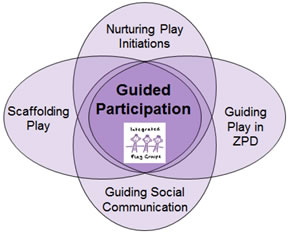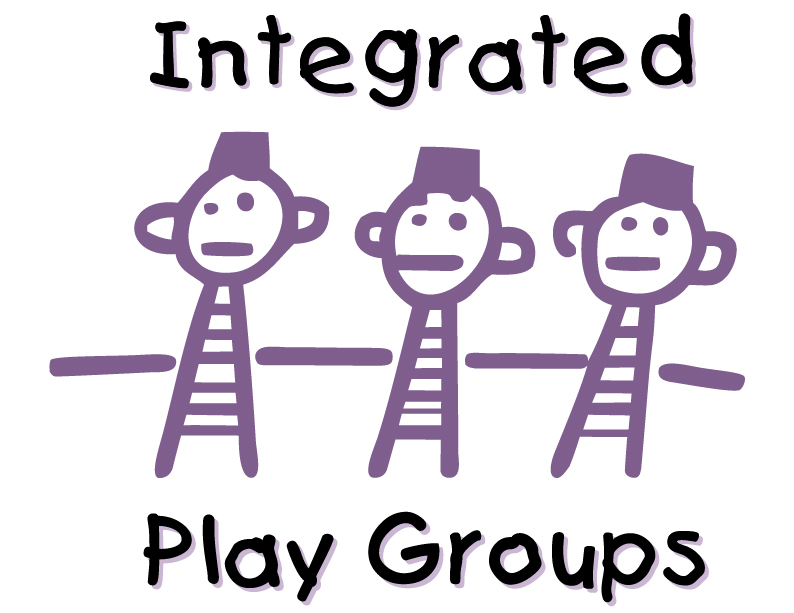 IPG Research
IPG Research
-
Antipolo, L. & Dichoso, D. (2003). The effects of integrated play groups with sensory integration on the play and social skills of children with sensory integrative dysfunction. Unpublished master’s thesis, San Jose State University, San Jose, California.
Bottema-Beutel, K., Turiel, E., DeWitt, M. N., & Wolfberg, P. J. (2017). To include or not to include: Evaluations and reasoning about the failure to include peers with autism spectrum disorder in elementary students. Autism, 21(1), 51–60. https://doi.org/10.1177/1362361315622412
Gonsier-Gerdin, J. (1992) Elementary school children's perspectives on peers with disabilities in the context of Integrated Play Groups: "They're not really disabled, they're like plain kids." (unpublished study) UC Berkeley-San Francisco State University, CA.
Jahnke, I., & Matthes, E. (2014): Integrative Theater-Gruppen für Jugendliche mit Asperger-Syndrom. Zeitschrift für Theaterpädagogik, 64, 53. [Integrated Theatre Groups] Lantz, J.F., Nelson, J.M. & Loftin, R.L. (2004) Guiding Children with Autism in Play: Applying the Integrated Play Group Model in School Settings. Exceptional Children, 37 (2), 8-14.
Mahnken, H., Baiardo, C., Naess, M., Pechter, R., Richardson, P. (2004, May).Integrated play groups and sensory integration for a child diagnosed with ASD: A case study. Poster presented at the American Occupational Therapy Association Annual Conference, Minneapolis, MI.
Mikaelian, B. (2003) Increasing language through sibling and peer support play. Unpublished Master Thesis, San Francisco State University, CA.
O’Connor, T. (1999). Teacher perspectives of facilitated play in Integrated Play Groups. Unpublished Master Thesis, San Francisco State University, CA.
Pearlstone, D. (2017) The effect of guided participation on the social communication performance of children on the autism spectrum in an inclusive program [Integrated Play Groups] Unpublished Master Thesis, San Francisco State University, CA
Remy, L. A better way to play? A physical activity based adaptation of the Integrated Play Groups model. Unpublished Master Thesis, San Francisco State University, CA.
National Research Council (2001) Educating Children with Autism. Committee on Educational Interventions for Children with Autism. Catherine Lord and James P. McGee, eds. Division of Behavioral and Social Sci- ences and Education. Washington, DC: National Academy Press. Richard, V, & Goupil, G. (2005). Application des groupes de jeux integres aupres d’eleves ayant un trouble envahissant du development (Implementation of Integrated Play Groups with Autism/PDD Students). Revue quebecoise de psychologie, 26(3), 79-103.
Schaefer, S.& Atwood, A. (2003). The effects of sensory integration therapy paired with integrated play groups on the social and play behaviors of children with autistic spectrum disorder. Unpublished master’s thesis, San Jose State University, San Jose, California.
Schuler AL. (2003) Beyond Echoplaylia: Promoting Language in Children with Autism. Autism. International Journal of Research and Practice;7(4):455-469. doi:10.1177/1362361303007004010
Schuler, A.L.& Wolfberg, P.J. (1992). Integrated play groups project: Final evaluation report (Contract # HO86D90016). Washington, DC: Department of Education, OSERS.
Wolfberg, P. J. (1988). Integrated play groups for children with autism and related disorders. Unpublished master's field study, San Francisco State University.
Wolfberg, P.J. (1994). Case illustrations of emerging social relations and symbolic activity in children with autism through supported peer play (Doctoral dissertation, University of California at Berkeley with San Francisco State University). Dissertation Abstracts International, #9505068.
Wolfberg, P.J. (1999;2009). Play and imagination in children with autism. New York: Teachers College Press, Columbia University (see original research Wolfberg, 1994.
Wolfberg, P.J., DeWitt, M., Young, G.S., & Nguyen, T. (2015) Integrated Play Groups: Promoting symbolic play and social engagement with typical peers in children with ASD across settings. Journal of Autism and Developmental Disorders. 45 (3), 830-845.
Yang, T., Wolfberg, P.J., Wu, S, Hwu, P. (2003) Supporting children on the autism spectrum in peer play at home and school: Piloting the Integrated Play Groups model in Taiwan. Autism: The International Journal of Research and Practice. 7 (4) 437-453.
Zercher, C., Hunt, P., Schuler, A.L., & Webster, J. (2001). Increasing joint attention, play and language through peer supported play. Autism: The International Journal of Research and Practice, 5, 374-398.
-
American Speech-Language-Hearing Association (2006). Guidelines for Speech-Language Pathologists in Diagnosis, Assessment, and Treatment of Autism Spectrum Disorders Across the Life Span.
DiSalvo, C. A.,Oswald, D. P. (2002). Peer-mediated interventions to increase the social interaction of children with autism: Consideration of peer expectancies. Focus on Autism and Other Developmental Disabilities, 17, 198–207.
Iovannone, R. Dunlop, G, Huber, H, & Kincaid, D. (2003). Effective educational practices for students with ASD. Focus on Autism and Other Developmental Disabilities, 18 (3), 150–165.
National Autism Center (2009). National Standards Project - Addressing the Need for Evidence-based Practice Guidelines for Autism Spectrum Disorders. National Autism Center Report.
National Research Council (2001) Educating Children with Autism. Committee on Educational Interventions for Children with Autism. Catherine Lord and James P. McGee, eds. Division of Behavioral and Social Sci- ences and Education. Washington, DC: National Academy Press.
Reichow B, & Volkmar F.R. (2010) Social skills interventions for individuals with autism: evaluation for evidence-based practices within a best evidence synthesis framework. Journal of Autism and Developmental Disorder,,40(2): 149-166.
Steinbrenner, J. R., Hume, K., Odom, S. L., Morin, K. L., Nowell, S. W., Tomaszewski, B., Szendrey, S., McIntyre, N. S., Yücesoy-Özkan, S., & Savage, M. N. (2020). Evidence-based practices for children, youth, and young adults with Autism. The University of North Carolina at Chapel Hill, Frank Porter Graham Child Development Institute, National Clearinghouse on Autism Evidence and Practice Review Team.
Wong, C., Odom, S. L., Hume, K. A., Cox, C. W., Fettig, A., Kurcharczyk, S., et al. (2015). Evidence-based practices for children, youth, and young adults with autism spectrum disorder: A comprehensive review. Journal of Autism and Developmental Disorders. doi: 10.1007/s10803-014-2351-z (see also, National Professional Development Center on ASD)
